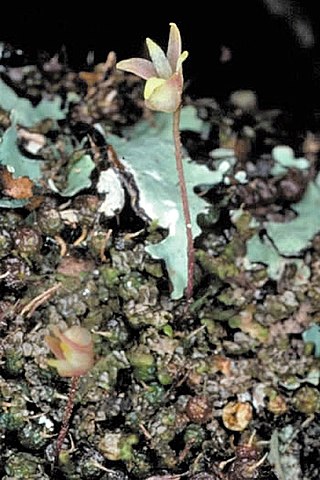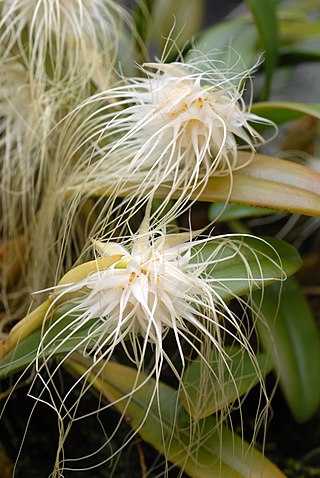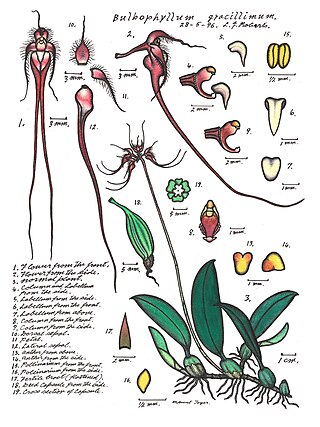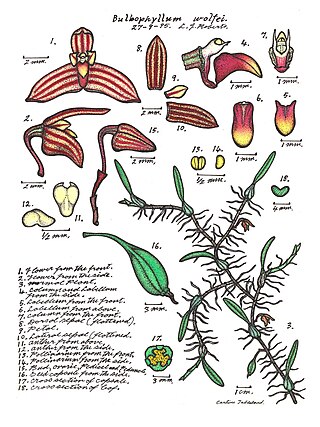
Orchids are plants that belong to the family Orchidaceae, a diverse and widespread group of flowering plants with blooms that are often colourful and fragrant. Orchids are cosmopolitan plants that are found in almost every habitat on Earth except glaciers. The world's richest diversity of orchid genera and species is found in the tropics.

Bulbophyllum is a genus of mostly epiphytic and lithophytic orchids in the family Orchidaceae. It is the largest genus in the orchid family and one of the largest genera of flowering plants with more than 2,000 species, exceeded in number only by Astragalus. These orchids are found in diverse habitats throughout most of the warmer parts of the world including Africa, southern Asia, Latin America, the West Indies, and various islands in the Indian and Pacific Oceans. Orchids in this genus have thread-like or fibrous roots that creep over the surface of trees or rocks or hang from branches. The stem is divided into a rhizome and a pseudobulb, a feature that distinguished this genus from Dendrobium. There is usually only a single leaf at the top of the pseudobulb and from one to many flowers are arranged along an unbranched flowering stem that arises from the base of the pseudobulb. Several attempts have been made to separate Bulbophyllum into smaller genera, but most have not been accepted by the World Checklist of Selected Plant Families.

Bulbophyllum globuliforme, commonly known as the green bead orchid, miniature moss-orchid or hoop pine orchid, is a species of epiphytic orchid with tiny spherical pseudobulbs, scale-like leaves and small cream-coloured flowers with a yellow labellum. It grows on the scaly bark of hoop pine, mostly on the McPherson Range on the New South Wales/Queensland border in eastern Australia. Because of its small size it is often dismissed as moss.

Johannes Jacobus Smith was a Dutch botanist who, between years 1905 to 1924, crossed the islands of the Dutch East Indies, collecting specimens of plants and describing and cataloguing the flora of these islands. The standard botanical author abbreviation J.J.Sm. is applied to plants described by J.J. Smith.

Louis-Marie Aubert du Petit-Thouars was an eminent French botanist known for his work collecting and describing orchids from the three islands of Madagascar, Mauritius and Réunion. The standard author abbreviation Thouars is used to indicate this person as the author when citing a botanical name.

Bulbophyllum medusae, commonly known as the Medusa orchid, is a species of epiphytic orchid with a creeping rhizome and a single leaf about 100 mm (3.9 in) long emerging from the top of each pseudobulb. The flowers are creamy yellow and arranged in clusters of about fifteen arranged in a circle at the tip of the flowering stem. The flowers have an unpleasant odour. The flowers have thread-like lateral sepals about 120 mm (4.7 in) long, giving each cluster the appearance of Medusa.
Oncophyllum is a genus in the orchid family, Orchidaceae, consisting of only two small species endemic to Australia, and previously classified as being in Bulbophyllum.
Bulbophyllum abbreviatum is a species of orchid in the genus Bulbophyllum discovered in Madagascar and originally described by German botanist Rudolf Schlechter, from material collected by French botanist H. Perrier de la Bâthie in February 1912, which is now kept in the Muséum National d'Histoire Naturelle in Paris.
Bulbophyllum algidum is a species of orchid in the genus Bulbophyllum discovered in former British New Guinea by the Wollaston Expedition of 1912–1913, led by Sandy Wollaston. The specimen was discovered at a high altitude, between 10,500 and 12,500 feet.
Bulbophyllum chimaera is a species of orchid in the genus Bulbophyllum.
Bulbophyllum dolichoglottis is a species of orchid in the genus Bulbophyllum, Section Codonosiphon Schlechter 1913. It is found only in New Guinea at approximately 700 meters. It grows best in intermediate temperatures with high humidity and fairly constant conditions year round.

Bulbophyllum gracillimum, commonly known as the wispy umbrella orchid, is a species of epiphytic orchid. It has a creeping rhizome, widely spaced, olive green pseudobulbs, each with a single thick, leathery, fleshy leaf and between six and ten purplish red flowers spreading in a semicircular umbel. The flowers have distinctive long, thread-like tails on the lateral sepals. It has a wide distribution and is found in New Guinea, New Caledonia, Indonesia, Malaysia and part of tropical North Queensland.
Bulbophyllum gyrochilum is a species of epiphytic orchid described by Gunnar Seidenfaden, in the genus Bulbophyllum.
Bulbophyllum macphersonii, commonly known as eyelash orchids, is a species of epiphytic or lithophytic orchid that is endemic to Queensland. It has tiny, crowded, slightly flattened, dark green pseudobulbs, a single thick, fleshy leaf and a single dark red to purplish red flower with a narrow labellum. It grows on trees and rocks in sheltered places.
Bulbophyllum minutissimum, commonly known as the red bead orchid or grain-of-wheat orchid, is a species of epiphytic or lithophytic orchid with small, flattened, reddish or green pseudobulbs, scale-like leaves and small whitish to reddish flowers with broad dar red stripes. It grows on trees and rocks, mostly in swamps and near streams in eastern Australia.
Bulbophyllum rhodoglossum is a species of orchid in the genus Bulbophyllum, first described by Rudolf Schlechter in 1913 in Repertorium Specierum Novarum Regni Vegetabilis. It is an epiphyte growing in Papua New Guinea on trees in mountain forests around 1000 metres in elevation. The flowers are white, and the labellum red with a yellow tip.

Bulbophyllum wolfei, commonly known as the fleshy snake orchid, is a species of epiphytic or lithophytic orchid with thin, creeping rhizomes, and flattened pseudobulbs each with a single thick, fleshy, dark green leaf and a single cream-coloured flower with dark red stripes. It mostly grows on rainforest trees in tropical North Queensland.
Bulbophyllum nocturnum is a species of epiphytic orchid that grows in New Britain. It was described in 2011, and is the first species of orchid known to consistently flower during the night, and close its flowers during the day.

Dendrobieae is a tribe in the subfamily Epidendroideae, in the family Orchidaceae. The Dendrobieae are mostly tropical, epiphytic orchids which contain pseudobulbs.









